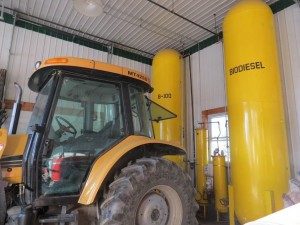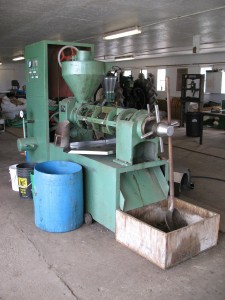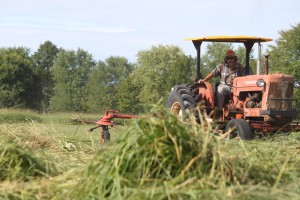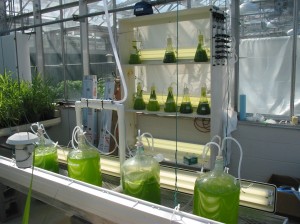21 Mar 2016
Vermont biodiesel success for Bourne’s Energy

Bourne’s Energy delivers Vermont biodiesel to customers.
Bourne’s Energy began to incorporate blended Vermont biodiesel into their fuel business in 2013, due in part to a grant from the Vermont Bioenergy Initiative paying for a facility to produce blended biodiesel. Since then the company has been able to replace over 300,000 gallons of fossil fuel with biodiesel. Bourne’s flagship B15 Biodiesel blend, dubbed “Bioheat®” for customer home heating needs, is a benefit to all aspects of the business—both financially and environmentally, not to mention positive to their growing sustainability image. Additionally, the company has been able to run their fleet from April to November on biodiesel, as well as operate pumps in Morrisville, Hardwick, Lyndonville and Montpelier that offer customers on/off road diesel or biodiesel.
“It’s been a success in every way to this point, and we’ve always had the privilege of a good product,” Peter Bourne stated referring to the biofuel coming from White Mountain Biodiesel in New Hampshire. The oil that White Mountain Biodiesel produces is from recycled cooking oil, an important attribute for Bourne’s Energy. Sustainable biodiesel is valued by Vermonters and fits into the local production for local use model promoted by the Vermont Bioenergy Initiative while avoiding controversies that arise from the food versus fuel debate.
Customers and local residents alike provided vastly positive feedback when Bourne’s began incorporating biodiesel into the mix and better yet, customers found the Bioheat® fuel blend to be quiet with no disruption in performance. Biodiesel is just “part of business as usual now,” Bourne concludes.
A long-time Bourne’s Energy customer noted, “I heat my home with oil and never thought much about it until my granddaughter helped me pay my bill online and saw that I was being delivered Bioheat®. I thought, ‘What the heck am I getting?’ I read all about it and found it allowed me to reduce my carbon footprint without doing a thing! It’s got me on the right track for doing what I can for cleaner air, our environment and a whole long list of things.”
In addition to the biodiesel-blended fuel, Bourne’s is expanding their bioenergy product line by further developing the infrastructure for their four year old bulk pellets program. Bourne’s sources quality pellets locally in Vermont and when demand exceeds supply, they source from New Hampshire, but choose not to go further for both economic and environmental reasons.
“We are a company really trying to reduce people’s consumption by supplying the right product at the right time. We can show it, we mean it, we’re doing it, and we’re not just flash,” Bourne shared in a recent conversation. The success and integrity of Bourne’s Vermont biodiesel work backs this claim, and positions Bourne’s Energy as a meaningful contributor to the development of Vermont Climate Economy.
26 Feb 2016
New Resource for Farmers: A Legal and Regulatory Overview of On-Farm Biodiesel Production in Vermont

State Line Farm in Shaftsbury, Vermont is an innovative bioenergy farm and research facility and worked with Institute for Energy and the Environment at Vermont Law School researchers on the On-Farm Biodiesel Production in Vermont: Legal and Regulatory Overview report.
A new report, On-Farm Biodiesel Production in Vermont: Legal and Regulatory Overview, conducted by the Institute for Energy and the Environment (IEE) at Vermont Law School reviews all Vermont state and federal regulations related to on-farm biodiesel production. Commissioned by the Vermont Bioenergy Initiative at the Vermont Sustainable Jobs Fund, the report aims to inform farmers about the potential laws and regulations surrounding on-farm biodiesel production.
“As statewide partners begin to find new ways to achieve the goals of Vermont’s Comprehensive Energy Plan, which identified biodiesel as a fuel that will help Vermont meet the 10-percent renewable transportation goal for 2025, the On-Farm Biodiesel Production in Vermont report provides a timely review of the regulations that pertain to home-grown biodiesel production,” states Ellen Kahler, executive director of the Vermont Sustainable Jobs Fund.
According to the report’s findings, “while several of the federal regulations are only triggered by high levels of production, there are a number of state laws and regulations that may be triggered by small-scale biodiesel production, such as state air emission provisions that establish lower thresholds when compared to the federal Clean Air Act (CAA). In addition, it is critical to understand the role biodiesel production plays in the definition of ‘farm’ and ‘farming activities’ for the purpose of states laws, such as Act 250 and the Current Use Program.”
IEE Global Energy Fellow Carla Santos coordinated the legal review with contributions from fellow IEE researchers Diana Chace, Christopher Cavaiola, Jeannie Oliver, and Jeremy Walker. The report is broken into five chapters that review tax legislation, site regulations, occupational safety and health, registration, and environmental legislation.
“Our institute’s research should help Vermont farmers understand the regulatory hurdles to producing biodiesel on the farm and help them convert a locally grown resource into economic and environmental benefits for Vermont,” said VLS Professor Kevin B. Jones, deputy director of the Institute for Energy and the Environment.
IEE researchers applied the legal review to three potential scenarios in the report, concluding with a convenient and accessible list of “do’s and don’ts” for farmers to use as a legal checklist as they move forward with producing biofuel in on-farm operations.
The complete On-Farm Biodiesel Production in Vermont: Legal and Regulatory Overview report is available on the Vermont Bioenergy Initiative website along with a variety of additional biofuel relevant reports and resources.
###
Since 2005, the Vermont Bioenergy Initiative has connected diversified agriculture and local renewable energy production for on-farm and community use by supporting research, technical assistance, and infrastructure development in emerging areas of bioenergy including biodiesel production and distribution for heating and transportation, oil crops for on-farm biodiesel and feed, grass for heating, and algae production for biofuels and wastewater management. The Vermont Bioenergy Initiative is a program of the Vermont Sustainable Jobs Fund, a non-profit organization created by the State of Vermont to help develop Vermont’s sustainable agriculture, renewable energy, and forest product businesses. For more information about the Vermont Bioenergy Initiative, visit www.VermontBioenergy.com.
The Institute for Energy and the Environment at Vermont Law School provides accessible resources on contemporary energy law and policy and is modeled on the fundamentals of a successful public policy consulting firm. The IEE distributes scholarly, technical, and practical publications; provides forums and conferences for professional education and issue development; and serves as a center for graduate research on energy issues, with environmental awareness. IEE research associates are selected from students in the energy and environmental programs at Vermont Law School, top-ranked in the nation for environmental law. For more information about the Institute for Energy and the Environment, visit vermontlaw.edu/iee.
09 Apr 2014
Emerging Frontiers in Bioenergy
Green Energy Times is an independent media company that publishes and energy independent website and newspaper. The power used to design the print publication and operate the website is completely off-the-grid and solar powered. Green Energy Times publishes all ranges of renewable energy and climate action news and articles from across Vermont and the region.
The Vermont Bioenergy is pleased to be authoring a regular column entitled Emerging Frontiers in Bioenergy. We plan to share each upcoming article on the Field Notes part of this website, and to get you up-to-speed, we wanted to share the first three in the series:
Oilseeds, Grass & Algae Each Hold a Place in Vermont’s Renewable Energy Future
This article reviews how bioenergy refers to renewable energy fuels and feedstocks derived from forest and agricultural biomass, liquid biofuels, and biogas to be used for heat, electricity, or vehicle fuel.
Grass Energy: State of the Science
This article explores the potential for grasses grown on marginal lands in Vermont to meet a portion of the state’s heating demand and reduce the consumption of fossil fuels and the study being conducted to assess the opportunities.
From Ponds to Fuel Tanks: The Role of Algae in our Energy Future
In this article, algae production is discussed as an excellent source of oil for making biodiesel, which could displace substantial volumes of petro-diesel for heating and transportation.
Learn more about Green Energy Times at www.GreenEnergyTimes.net and the Vermont Bioenergy Initiative at www.VermontBioenergy.com.








